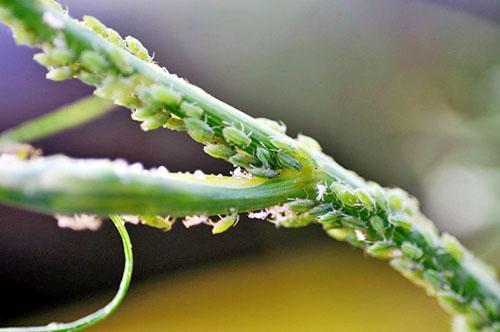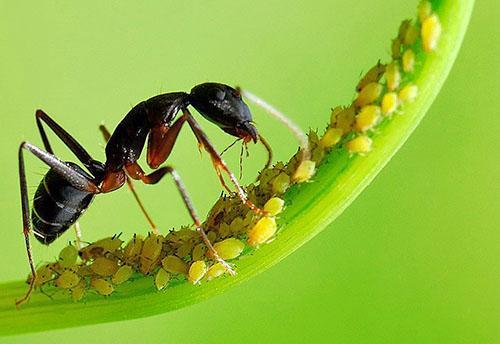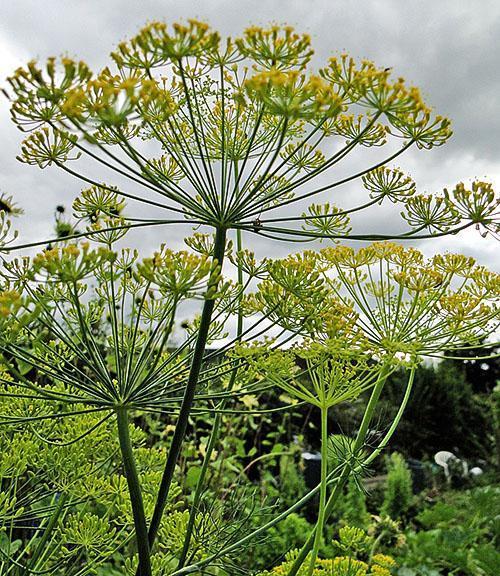Tips on how to get rid of aphids on dill
 Several species of aphids parasitize on dill at once, giving from 12 to 18 generations per season and causing serious harm to green culture. Ants using and settling these insects feed on sweet honeydew secreted by aphids. Its traces on the plant are one of the first signs of danger threatening plantings. In addition to sticky, sweet spots, a sure sign of the presence of a pest is whitish, ash-like scales. This is an old shell discarded by aphids.
Several species of aphids parasitize on dill at once, giving from 12 to 18 generations per season and causing serious harm to green culture. Ants using and settling these insects feed on sweet honeydew secreted by aphids. Its traces on the plant are one of the first signs of danger threatening plantings. In addition to sticky, sweet spots, a sure sign of the presence of a pest is whitish, ash-like scales. This is an old shell discarded by aphids.

Due to the rapid reproduction of aphids, dill quickly turns out to be literally stuck with insects. As a result, the greens do not develop, they are deformed, with aphids, in addition, infections dangerous for the plant can be transferred to the dill beds, for example, harmful fungi, whose colonies on the greens look like spots of oily soot. What to do if aphids on dill are a real threat to the crop?
If garden plants on which there are no ready-to-harvest fruits, potatoes or ornamental crops can be safely treated with insecticides, then it is quite dangerous to spray greens with chemicals. Therefore, in order not to fight aphids on dill, great attention is paid to prevention, adherence to agricultural techniques and crop rotation, as well as the use of biological products and folk remedies.
How to get rid of aphids on dill, so as not to lose the crop, the greens have not lost their properties and remain safe for humans?
Preventive measures against aphids on dill
 For sowing dill, ventilated, well-lit areas are chosen. Excessive seedling density should not be allowed, since aphids and other pests settle on elongated plants that do not receive nutrition and moisture in the first place. Aphid larvae hibernate on plant debris, weeds and already infected cultivated plants that leave before winter. In the spring, pests capture the seedlings that appear from under the ground and begin to actively multiply. What to do so that aphids on dill do not ruin the crop of vitamin greens?
For sowing dill, ventilated, well-lit areas are chosen. Excessive seedling density should not be allowed, since aphids and other pests settle on elongated plants that do not receive nutrition and moisture in the first place. Aphid larvae hibernate on plant debris, weeds and already infected cultivated plants that leave before winter. In the spring, pests capture the seedlings that appear from under the ground and begin to actively multiply. What to do so that aphids on dill do not ruin the crop of vitamin greens?
If you take care of the removal of weeds, dry stalks of dill and other umbellates infected with similar types of insects in time, then the risk of crop loss from aphids will dramatically decrease.
Equally beneficial is a careful examination of the plants, especially the back of the foliage and sinuses, where aphids accumulate most often. Single pests detected and manually removed in time will not be able to create a large population, and the plants will be saved.
 We must not forget about the rules of crop rotation. You should not sow dill in areas where carrots, celery and parsley were previously grown, as well as similar species affected by the same types of pests. And it is better not to plant such plants in neighboring beds. To protect dill from aphids and other insect pests, it is useful to alternate the beds with this crop with garlic and onions. Many herbs, such as coriander, basil, mint and fennel, have aphid repellent effect.
We must not forget about the rules of crop rotation. You should not sow dill in areas where carrots, celery and parsley were previously grown, as well as similar species affected by the same types of pests. And it is better not to plant such plants in neighboring beds. To protect dill from aphids and other insect pests, it is useful to alternate the beds with this crop with garlic and onions. Many herbs, such as coriander, basil, mint and fennel, have aphid repellent effect.
Competently used ornamental plants will also help.Phytoncides of marigolds, Dalmatian and pharmacy chamomile have a depressing effect on the pest. Kosmeya planted next to the dill beds, as well as lavatera, mallow and tuberous begonia, as well as a number of legumes, distract aphids from dill.
 But sowing this greens near viburnum bushes, linden trees and bird cherry trees is not worth it. These plants primarily attract a dangerous pest and can become a source of infection for nearby beds.
But sowing this greens near viburnum bushes, linden trees and bird cherry trees is not worth it. These plants primarily attract a dangerous pest and can become a source of infection for nearby beds.
You can save dill from aphid attack using non-woven covering material of the lowest density. Such fabric allows heat and light to pass through, is light enough not to harm plant growth, but does not allow insects to penetrate and fix on leaves and shoots. How to treat aphids on dill in order to get rid of insects as safely and quickly as possible?
If aphids nevertheless appear on dill, insects are washed off the greenery with a powerful jet of water, and heavily affected plant parts are cut off and destroyed.
Since garden ants are engaged in the settlement of aphids, the accumulation of these insects on garden plantations cannot be ignored. In the fight against ants, specialized insecticides will help, the treatment of which must be carried out away from crops of green crops.
How to handle aphids on dill?
 Today, gardeners and gardeners are offered a variety of highly effective insect control products that also work against aphids. But is it possible to eat dill if aphids, and with it the greens, are treated with such preparations? Obviously, this is very dangerous due to the risk of chemicals getting on the person's table. How to get rid of aphids from dill and not be afraid that the greens will become toxic? The safest are biological products that do not harm humans and other warm-blooded organisms, but effectively destroy not only aphids, but also many common insect pests.
Today, gardeners and gardeners are offered a variety of highly effective insect control products that also work against aphids. But is it possible to eat dill if aphids, and with it the greens, are treated with such preparations? Obviously, this is very dangerous due to the risk of chemicals getting on the person's table. How to get rid of aphids from dill and not be afraid that the greens will become toxic? The safest are biological products that do not harm humans and other warm-blooded organisms, but effectively destroy not only aphids, but also many common insect pests.
After spraying dill with phytoverm, the bulk of the aphid dies after 2 - 3 days. At the same time, the maximum effect lasts up to seven days, and in dry weather fitoverm can fight aphids on greenery for up to 3 weeks. How else to treat aphids on dill? Similarly, but for 5 days, enterobacterin accumulates and exerts its effect, which has proven itself well at elevated air temperatures in the range of 28–30 ° C. In the list of such drugs, it is worth paying attention to biotlin.
 Foliar dressing from solution can increase the protective forces of dill superphosphate and potassium chloride in a 2: 1 ratio. 30 grams of a mixture of fertilizers are dissolved in 10 liters of water and sprayed with dill, not bypassing the lower parts of the leaves and the root zone. After a week, the treatment is repeated.
Foliar dressing from solution can increase the protective forces of dill superphosphate and potassium chloride in a 2: 1 ratio. 30 grams of a mixture of fertilizers are dissolved in 10 liters of water and sprayed with dill, not bypassing the lower parts of the leaves and the root zone. After a week, the treatment is repeated.
In the case of using modern means of combating aphids, it is possible to harvest and use greens for food 5–6 days after spraying.
How to deal with aphids on dill without endangering yourself and your family members? It is possible to get rid of aphids on dill without resorting to artificial means.
How to deal with aphids on dill with folk remedies
 Aphids die after spraying greens with a soapy solution, which requires 10 liters of water and 100 grams of liquid soap or detergent to prepare. If these compounds are not at hand, 300 grams of grated laundry soap will do. For greater efficiency, 150–250 grams of wood ash can be added to the hot soapy solution. After cooling, the plants are sprayed with the agent, and if it is necessary to use dill for food, it is enough to rinse the bundles in warm water.
Aphids die after spraying greens with a soapy solution, which requires 10 liters of water and 100 grams of liquid soap or detergent to prepare. If these compounds are not at hand, 300 grams of grated laundry soap will do. For greater efficiency, 150–250 grams of wood ash can be added to the hot soapy solution. After cooling, the plants are sprayed with the agent, and if it is necessary to use dill for food, it is enough to rinse the bundles in warm water.
Not only chemicals have a deterrent and depressing effect on aphids, but also many plants that can be found right there in the beds and flower beds.
In suburban conditions, when aphids are already on dill, you can use good help - rich infusions from:
- tops of tomatoes or potatoes;
- chopped onions and husks;
- garlic;
- pharmacy chamomile;
- marigolds;
- yarrow herbs;
- celandine;
- hot capsicum;
- horse sorrel.
To prepare the infusion, you can use shag and mustard powder. It is good when such funds are used in combination with soapy water and agrotechnical techniques.
There are many ways to deal with aphids on dill. I'll add a few more to the piggy bank. If you use the EM-1 Baikal working solution for spraying beds with herbs once a week, no pests, including aphids, will colonize them. Only the solution should be its own dilution from the concentrate, since there are many fakes of this drug.
It is for dill that treatment with a five-day infusion of nettle helps well. This solution changes the cellular composition of the juice, and it becomes unpalatable to the aphids. Watering and spraying should be done every week.
I use this method constantly on onions and dill. As soon as signs of a pest appear, I spread 2 tablespoons of a bath liquid based on ethyl alcohol or the same amount of unrefined smelling moonshine in 10 liters of water and spray the beds with a fine spray. Aphids fall, they are alive, so you need to loosen the ground and bury it. For dill, it's like a top dressing. The smell lasts for a long time.
If you want safety from chemistry, then all that remains is repeated rinsing with running cold water, first rinse several times in a deep dish until the aphids disappear, rinsing under the tap in intervals. This is simple in my opinion and everyone should know.